On October 5 in the Independent Press Center a press conference on the results of the survey of migrant workers was held
Дата публикации: 10/09/2012By Marina Glazkova
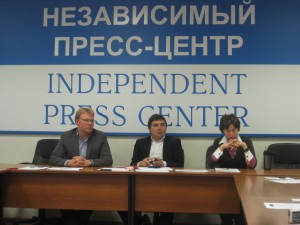 Today, Moscow is a central attraction for labor migration from the former Central Asian republics of the USSR. What kind of people are they, what were the reasons they came, what are their outlook and beliefs, what do they think about us, and what are their most urgent problems? These questions were asked by “SREDA” in the summer of 2012. As a result, the survey was conducted among 400 respondents who applied to the Russian Federal Migration Service (FMS) office in Moscow. The research allowed “SREDA” to make portraits of the migrant workers who are citizens of Uzbekistan (38%), Tajikistan (24%) and Kyrgyzstan (23%).
Today, Moscow is a central attraction for labor migration from the former Central Asian republics of the USSR. What kind of people are they, what were the reasons they came, what are their outlook and beliefs, what do they think about us, and what are their most urgent problems? These questions were asked by “SREDA” in the summer of 2012. As a result, the survey was conducted among 400 respondents who applied to the Russian Federal Migration Service (FMS) office in Moscow. The research allowed “SREDA” to make portraits of the migrant workers who are citizens of Uzbekistan (38%), Tajikistan (24%) and Kyrgyzstan (23%).
To open the conference, the coordinator of “SREDA”, Alina Bagrina, outlined the scientific and practical importance of the study, and noted thatsuch work should be carried out systematically and, when possible, with the involvement of different research tools. This study is a test step. The importance of this issue is not limited to metropolitan areas, but it is important for the Russian society as a whole, especially if we take into account the increasing density of communication and social relations in current global economic trends.
In Europe, migrant workers are an obvious phenomenon. . According to various estimates, in London today, there are about 1 million migrants, and Moscow is already close to that figure, when both legal and illegal migration is counted. Currently, migrant workers in Moscow are not as noticeable and do not behave as confidently, as in London, where the existing diasporas feel as if they are the masters of the city, but it may only be a question of time. It can be assumed that within 15-20 years,civil society will consist largely of migrant children, who are “passionate, enterprising, hardened, and have the experience of ‘non-guaranteed survival’ in the terminology of R. Inglhardt”. «“The direction of how our relationship will be constructed is being built now,” », – said the head of Sreda. According to Bagrina, the possible fear of the native Muscovites before the “invasion of immigrants” was provoked by the process moving at a high speed, resulting in a “division of ‘us vs. them.’” What often escapes attention is the fact that «”those who come to Moscow are good people, who are willing to work, to help their loved ones, and to have children”, and have strong conservative and patriarchal values, and an outlook centered on religion.
The next presentation outlined the results of a study by Vladimir Blinov, an expert of “Sreda”. Citizens of Uzbekistan (38%), Tajikistan (24%) and Kyrgyzstan (23%) were interviewed while in line at the FMS. 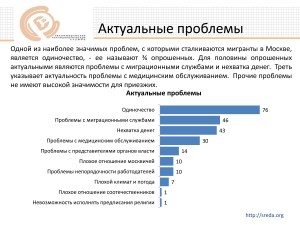 The vast majority of these people are men (90%) aged 18 to 34 years. In general, they have a technical secondary education (70%), and they came to Russia in order to earn money (99%). Their income is less than 30,000 rubles (74%). In 75% of the cases, the family of respondents remained in their homeland, and 73% of the immigrants send money there.
The vast majority of these people are men (90%) aged 18 to 34 years. In general, they have a technical secondary education (70%), and they came to Russia in order to earn money (99%). Their income is less than 30,000 rubles (74%). In 75% of the cases, the family of respondents remained in their homeland, and 73% of the immigrants send money there.
At the same time, 88% of respondents consider themselves happy. “We know the living conditions of migrant workers, and the difficulties they face. Still, however, they say that they are happy. This gives us important information about their value system,” said Blinov.
What challenges for migrants are most relevant? Curiously, it is not financial difficulties or complaints about the authorities, but loneliness, which worried 76% of respondents. At the same time, only 10% of migrants complained about the bad attitude of Muscovites.
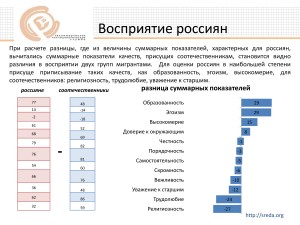 It turned out that the newcomers believed that the primary characteristics of Muscovites were honesty (83%), independence (83%), and education (81%). Muscovites were least associated with arrogance (41%), self-interest (36%), and religiosity (63%). The most characteristic qualities of fellow migrants were diligence (92%), independence (87%), and honesty (87%).
It turned out that the newcomers believed that the primary characteristics of Muscovites were honesty (83%), independence (83%), and education (81%). Muscovites were least associated with arrogance (41%), self-interest (36%), and religiosity (63%). The most characteristic qualities of fellow migrants were diligence (92%), independence (87%), and honesty (87%).
45% of respondents indicate that they would like to become citizens of Russia in the future. The greatest desire to stay in Russia is found with citizens of Kyrgyzstan (42%) and Tajikistan (54%), and is found the least in visitors from Uzbekistan (29%). “This suggests that migrant workers who arrived and got permission to work, may become part of our society, and may become Russians” said Blinov. However, the majority of respondents (64%) do not want their children to become like the Russians. The vast majority of respondents said that they frown upon the prospect of their children becoming followers of the Russian Orthodoxy (82%).
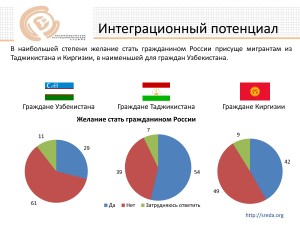 If we talk about the religious identification of immigrants, then citizens of Tajikistan represent the highest percentage of those who belong to Islam and adhere to its religious practices. Among them, the largest number is Sunni Muslims (71%) and lowest number of those who do not know what branch of Islam they belong to (14%). Among the citizens of Kyrgyzstan, 52% are Sunni, and 29% do not know; among the citizens of Uzbekistan, it is 58% and 28%, respectively. Among immigrants from Tajikistan the proportion of those who regularly attend mosque is higher (21%), compared with immigrants from Kyrgyzstan (9%) and Uzbekistan (8%).
If we talk about the religious identification of immigrants, then citizens of Tajikistan represent the highest percentage of those who belong to Islam and adhere to its religious practices. Among them, the largest number is Sunni Muslims (71%) and lowest number of those who do not know what branch of Islam they belong to (14%). Among the citizens of Kyrgyzstan, 52% are Sunni, and 29% do not know; among the citizens of Uzbekistan, it is 58% and 28%, respectively. Among immigrants from Tajikistan the proportion of those who regularly attend mosque is higher (21%), compared with immigrants from Kyrgyzstan (9%) and Uzbekistan (8%).
As to the level of proficiency in Russian, half of the respondents said that they easily read (51%) and write (48%) in Russian, and less than half say they have “some difficulties” with their reading and writing skills. However, according to the interviewers who conducted the study, only 34% of the respondents speak Russian fluently, and the rest experience certain difficulties. Tajiks are somewhat worse than others when speaking Russian.
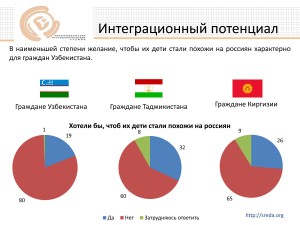 If we talk about socializing the migrants, one possible way is through the organization of free courses in the Russian language. 40% of migrants have expressed a desire to attend such courses. Those who want to go to the courses the most are the Tajiks (55%).
If we talk about socializing the migrants, one possible way is through the organization of free courses in the Russian language. 40% of migrants have expressed a desire to attend such courses. Those who want to go to the courses the most are the Tajiks (55%).
One more possible way may be educational programs taken over the internet, as this can be much more accessible to the migrants. As noted by all participants, the level of internet use among Moscow’s migrant workers has grown rapidly in recent years. For example, according to the survey by “Sreda”, every second respondent uses the internet.
In summing up the results of the research, Alina Bagrina noted that, in general, the Uzbeks are somewhat more optimistic and are still relatively closed to integration. The Kyrgyz are slightly younger, are less likely to help families left behind, and are a little more likely to report problems with the immigration authorities. Tajiks are the most consistent Sunni Muslims, and on average, they remain in Moscow the longest period of time. “All three groups belong to different cultures, and support different traditions, and it is important not to cultivate a stereotypical image of them, but respect the differences of new Muscovites ,” stressed Bagrina.
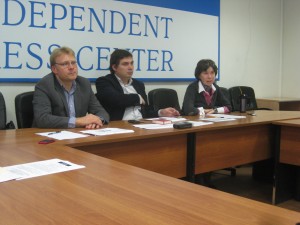 Continuing the press conference, an expert from “Sreda” and a leading researcher at the Institute of Europe of Russian Academy of Sciences, Roman Lunkin illustrated the problem with data from another research by Sreda, – , with the project “ARENA”(“Atlas of Religions and Nationalities”, it is the survey representative of the subjects of the Russian Federation, and was conducted in the summer of 2012, and consists of responses from 56,000 Russians). In this survey we learned about the attitudes of Russians towards migrants. Lunkin noted that 20% of respondents in Russia are wary of migrants (to migrants of other nationalities), but the attitude is different within different parts of the country. The most “wary” are the respondents from St. Petersburg (40%) and the Leningrad region (37%). The most loyal to the migrants were residents of the Smolensk region (4%) and North Ossetia (4%). Respondents who declared themselves as “orthodox” and live a more active religious life (go to church regularly, read the Gospel) show a relatively high percentage of wariness with respect to the migrants. On the other hand, there are also some more “wary” people among civil society activists, people willing to engage in business of their own, and patriots.
Continuing the press conference, an expert from “Sreda” and a leading researcher at the Institute of Europe of Russian Academy of Sciences, Roman Lunkin illustrated the problem with data from another research by Sreda, – , with the project “ARENA”(“Atlas of Religions and Nationalities”, it is the survey representative of the subjects of the Russian Federation, and was conducted in the summer of 2012, and consists of responses from 56,000 Russians). In this survey we learned about the attitudes of Russians towards migrants. Lunkin noted that 20% of respondents in Russia are wary of migrants (to migrants of other nationalities), but the attitude is different within different parts of the country. The most “wary” are the respondents from St. Petersburg (40%) and the Leningrad region (37%). The most loyal to the migrants were residents of the Smolensk region (4%) and North Ossetia (4%). Respondents who declared themselves as “orthodox” and live a more active religious life (go to church regularly, read the Gospel) show a relatively high percentage of wariness with respect to the migrants. On the other hand, there are also some more “wary” people among civil society activists, people willing to engage in business of their own, and patriots.
 The experts present drew attention to the typical problem of loneliness felt by the migrants, Russian language courses, and religion. Julia Florinskaya (an official of the Center for Migration Studies) noted that the figure of those who know the Russian language obtained in the study is sufficiently high and suggests that the socialization of migrants is not connected with the study of the Russian language. The experts agreed with the notion that integrated measures are needed for the integration of immigrants, including a civil literacy campaign, not only courses in Russian language and culture. Roman Lunkin drew the attention of the discussion to the following fact: 12% of migrant workers regularly visit the mosque, and therefore, the number of active believing migrants in Moscow is about 100 thousand people. For many migrants, attending worship services in a mosque is an opportunity to find themselves in a close-knit ethnic and cultural environment.
The experts present drew attention to the typical problem of loneliness felt by the migrants, Russian language courses, and religion. Julia Florinskaya (an official of the Center for Migration Studies) noted that the figure of those who know the Russian language obtained in the study is sufficiently high and suggests that the socialization of migrants is not connected with the study of the Russian language. The experts agreed with the notion that integrated measures are needed for the integration of immigrants, including a civil literacy campaign, not only courses in Russian language and culture. Roman Lunkin drew the attention of the discussion to the following fact: 12% of migrant workers regularly visit the mosque, and therefore, the number of active believing migrants in Moscow is about 100 thousand people. For many migrants, attending worship services in a mosque is an opportunity to find themselves in a close-knit ethnic and cultural environment.
Those present noted that this survey of migrants is a step towards the research of specific parts of our society, ethno-cultural and spiritual needs that often fall out of the field of view of politicians, officials, journalists, and even representatives of the expert community. The images of migrants, offered by the organization “Sreda”, help us see the future shape of the capital of a multicultural society.

